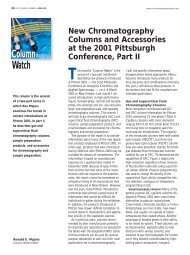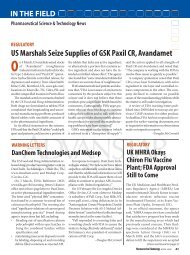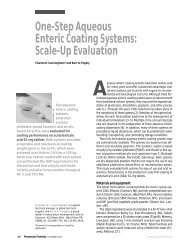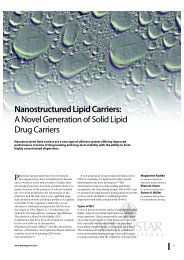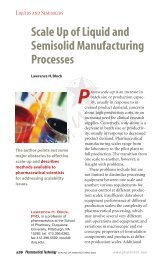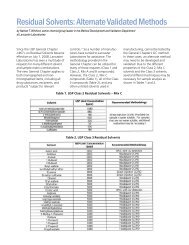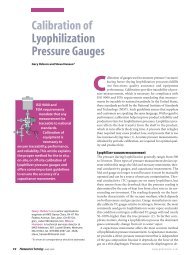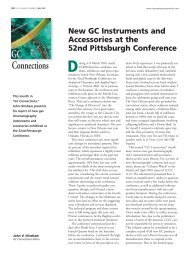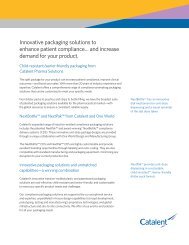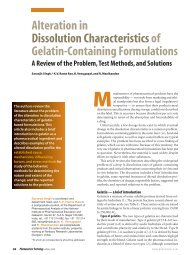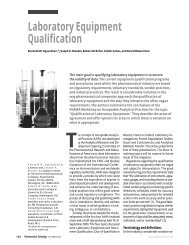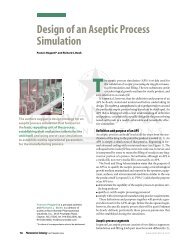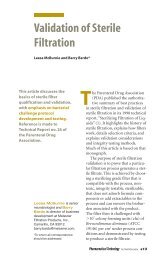Oral Low Molecular Weight Heparin Absorption - Pharmaceutical ...
Oral Low Molecular Weight Heparin Absorption - Pharmaceutical ...
Oral Low Molecular Weight Heparin Absorption - Pharmaceutical ...
You also want an ePaper? Increase the reach of your titles
YUMPU automatically turns print PDFs into web optimized ePapers that Google loves.
<strong>Oral</strong> <strong>Low</strong> <strong>Molecular</strong> <strong>Weight</strong><br />
<strong>Heparin</strong> <strong>Absorption</strong><br />
From Solution and Solid Dosage Forms<br />
in Rat, Dog, and Monkey Models<br />
Andrea Leone-Bay,* Catherina O’Shaughnessy, Rajesh Agarwal,<br />
Theresa Rivera-Schaub, Connie Rosado-Gray, Linda Gerspach, and<br />
Robert A. Baughman<br />
EMISPHERE<br />
Parenteral low molecular weight heparin (LMWH) is the standard<br />
of care for the prevention of deep vein thrombosis in patients<br />
undergoing joint replacement or abdominal surgery. LMWH is not<br />
absorbed after oral dosing. This article describes the delivery<br />
agent–mediated transport of LMWH across Caco-2 cells. These<br />
agents are shown to facilitate oral LMWH absorption in rats, dogs,<br />
and monkeys.<br />
Andrea Leone-Bay is a senior<br />
director of project management at<br />
Emisphere Technologies, Inc.,<br />
765 Old Saw Mill River Road, Tarrytown,<br />
NY 10591, tel. 914.785.4733, fax<br />
914.593.8281, aleone-bay@emisphere.<br />
com. Catherina O’Shaughnessy<br />
is a senior research associate; Rajesh<br />
Agarwal is a director of pharmaceutics<br />
R&D; Theresa Rivera-<br />
Schaub is a project manager;<br />
Connie Rosado-Gray is a project<br />
coordinator; Linda Gerspach is a<br />
research associate; and Robert A.<br />
Baughman is a senior vice-president<br />
of development at Emisphere<br />
Technologies, Inc.<br />
*To whom all correspondence should be<br />
addressed.<br />
Parenteral low molecular weight heparin (LMWH) has<br />
replaced warfarin as the standard of care for the prevention<br />
of deep vein thrombosis (DVT) and pulmonary<br />
embolism in high-risk, hospitalized patients undergoing<br />
joint replacement or abdominal surgery (1). LMWH is favored<br />
over antivitamin K oral anticoagulants such as warfarin<br />
because it produces a rapid onset of anticoagulant activity and<br />
has a short physiological half-life (2). Compared with warfarin,<br />
LMWH has a significantly lower incidence of drug–drug interaction.<br />
Anticoagulation with LMWH typically is evidenced<br />
by its effect on plasma LMWH concentrations measured by the<br />
anti-Factor Xa assay. The target therapeutic range for DVT prophylaxis<br />
is 0.1–0.2 IU/mL (2). With the use of fixed doses, continuous<br />
monitoring generally is unnecessary, and untoward hemorrhage<br />
rarely occurs. The major disadvantage of LMWH<br />
therapy is that it must be parenterally administered because it<br />
is ineffective when dosed orally (3,4). Thus, LMWH usually is<br />
replaced by oral warfarin for outpatient therapy. Unfortunately,<br />
this switch from parenteral LMWH to oral warfarin often requires<br />
prolonged hospitalization for the patient because the delayed<br />
onset of action, the prolonged half-life, and the variable<br />
response to warfarin necessitate a gradual increase in dose as<br />
the LMWH dose is slowly decreased. An oral LMWH formulation<br />
would allow for continuous LMWH treatment of outpatients,<br />
thereby eliminating the need to change to warfarin.<br />
Several recent attempts to develop effective oral LMWH formulations<br />
have been reported. For example, LMWH complexes<br />
with tertiary diamines have shown limited oral bioavailability<br />
38 <strong>Pharmaceutical</strong> Technology MARCH 2002 www.pharmtech.com
upon intraduodenal administration to rabbits (5). Administration<br />
of LMWH in a lipid matrix composed of phosphatidylcholine<br />
from soy protein and medium-chain monoacylglycerols<br />
has improved absorption in the small intestine of<br />
rabbits (6). Other approaches have included the use of glycerol<br />
esters of fatty acids (7) and non-ionic surfactants (8) to increase<br />
the absorption of orally dosed LMWH. Recently, studies have<br />
been conducted in which high doses of LMWH alone have been<br />
administered orally to rabbits (9,10). In general, these experiments<br />
have met marginal success.<br />
<strong>Oral</strong> unfractionated heparin (UFH) absorption in rats (11),<br />
monkeys (12), and healthy human subjects (13) following the<br />
administration of an aqueous solution containing UFH and a<br />
delivery agent have been reported. These delivery agents are<br />
low molecular weight compounds that can be dissolved in water<br />
with UFH (11). <strong>Oral</strong> administration of this solution mixture<br />
results in the gastrointestinal absorption of UFH. One of these<br />
delivery agents, sodium 8-[N-(2-hydroxybenzoyl)amino]<br />
caprylate (SNAC), is the subject of advanced clinical studies<br />
(13). Thus, therapeutic levels of anticoagulation, as measured<br />
by increased activated partial thromboplastin time (APTT)<br />
and anti-Factor Xa activity, were obtained following single oral<br />
doses of the SNAC–UFH combination as a flavored syrup. We<br />
also have demonstrated the efficacy of this oral SNAC–UFH<br />
combination for the prevention (14) and treatment (15) of<br />
DVT in a rat model of venous thrombosis. These studies show<br />
that orally delivered UFH is as effective as injectable UFH in<br />
this model.<br />
As part of our continued research in this therapeutic, we have<br />
investigated the delivery agent–facilitated gastrointestinal absorption<br />
of LMWH. In this article, we report on the effects of<br />
oral LMWH delivery facilitated by SNAC and a more efficient<br />
delivery agent, sodium 10-[N-(2 hydroxybenzoyl)amino]decanoate<br />
(SNAD). SNAC and SNAD are compared for their abilities<br />
to transport LMWH across Caco-2 cells in vitro as well as<br />
to facilitate oral LMWH absorption in rats, dogs, and monkeys<br />
from aqueous solutions and tablets.<br />
Materials and methods<br />
Materials. SNAC and SNAD were synthesized at Regis Laboratories<br />
(Chicago, IL). LMWH (Parnaparin) (91 IU/mg) was purchased<br />
from Opocrin Laboratories (Modena, Italy). Propylene<br />
glycol was purchased from Aldrich Chemical Company (Milwaukee,<br />
WI). Plasma samples and cell culture samples were analyzed<br />
for anti-Factor Xa activity using an LMW heparin–UF<br />
heparin assay (Coatest, Chromogenix Instrumentation Laboratory,<br />
S.p.A, Milano, Italy). <strong>Heparin</strong> concentrations (IU/mL)<br />
were extrapolated from a standard curve. Concentrations 0.05<br />
IU/mL were considered significant (16). No interference resulted<br />
from SNAC or SNAD in these assays.<br />
Preparation of dosing solutions. Solutions of SNAC/LMWH<br />
and SNAD/LMWH were prepared in either 25% (v/v) aqueous<br />
propylene glycol or water as follows: Water or a solution of 25%<br />
(v/v) aqueous propylene glycol was added to a dry mix of<br />
SNAC/LMWH or SNAD/LMWH. The resulting suspension was<br />
mixed by vortex and then placed in a 37 C ultrasonic water<br />
bath for 10–15 min until a clear solution was obtained. The solution<br />
was brought to its final volume with either water or 25%<br />
v/v aqueous propylene glycol. Typically, the final solutions contained<br />
100 mg/mL SNAC or SNAD and 91 IU/mL LMWH at<br />
pH 7.5–8.5.<br />
Preparation of tablets. SNAD/LMWH tablets were manufactured<br />
at Elan <strong>Pharmaceutical</strong> Technologies (San Francisco, CA)<br />
by direct compression. The SNAD/LMWH tablets each contained<br />
275 mg SNAD and 45,000 U heparin.<br />
Caco-2 cell culture. Caco-2 cells were obtained from American<br />
Tissue Culture Collection (Rockville, MD). The cells were maintained<br />
in Dulbecco’s modified eagle’s medium that contained<br />
10% heat-inactivated fetal bovine serum, 1% nonessential amino<br />
acids, penicillin (100 units/mL), and streptomycin (100 g/mL)<br />
in an atmosphere of 95% air and 5% carbon dioxide as previously<br />
described (17). All cell culture media were obtained from<br />
GibcoBRL (Invitrogen Corp., Carslbad, CA). For transport studies,<br />
the cells were seeded onto Costar Transwell (Corning Inc.,<br />
Aeton, MA) polycarbonate filters (12-mm diameter, 0.4-m<br />
pore size) at a density of 5 10 5 cells per filter. Cells between<br />
passages 25 and 35 were used. The cells were fed every 48 h and<br />
were allowed to grow and differentiate for as long as 20 days<br />
before the monolayers were used in drug transport experiments.<br />
Drug transport studies (Caco-2). Solutions of SNAC/LMWH<br />
and SNAD/LMWH were prepared in Hank’s buffered saline<br />
solution supplemented with 11 mM glucose and 25 mM N-[2-<br />
hydroxyethyl]piperazine-N’-[2-ethanesulfonic] acid. Final concentrations<br />
of the delivery agent (SNAC or SNAD) and LMWH<br />
applied to the apical side of the monolayers were 5.0 mg/mL<br />
and 60 mg/mL (5460 IU/mL), respectively. Basolateral samples<br />
were taken every 30 min for 2 h and replaced with fresh<br />
buffer. These were analyzed using the anti-Factor Xa activity<br />
assay. The integrity of the cell monolayers was monitored by<br />
measuring transepithelial electrical resistance (TEER) immediately<br />
before the addition of donor solutions (apical side) and<br />
again after 2 h. In addition, trypan blue staining of the monolayers<br />
at the end of each experiment was used to verify monolayer<br />
integrity.<br />
Determination of the permeability coefficients and enhancement<br />
ratios. The apparent permeability coefficient (P app<br />
,cm/s) was<br />
calculated according to Kotz et al. (18) using the following<br />
equation:<br />
in which dC/dt is the steady-state rate of change in the drug<br />
concentration in the receiver chamber (g mL 1 s 1 ), V R<br />
is the<br />
volume in the receiver chamber (mL), A is the surface area of<br />
the cell monolayer (1.13 cm 2 ), and C 0<br />
is the initial concentration<br />
in the donor chamber (g/mL). All experiments were carried<br />
out under “sink” conditions. The enhancement ratio was<br />
calculated by dividing the P app<br />
of LMWH obtained in the presence<br />
of the delivery agent by the control P app<br />
of LMWH alone.<br />
Animal studies. Animal protocols (rats and dogs) were reviewed<br />
and approved, where appropriate, in advance by the<br />
Institutional Animal Care and Use Committee. Animal protocols<br />
(monkeys) were approved in advance by ITR Labora-<br />
40 <strong>Pharmaceutical</strong> Technology MARCH 2002 www.pharmtech.com<br />
[1]
Table I: Summary of Caco-2 studies.*<br />
SNAC<br />
SNAD<br />
Delivery Agent LMWH P app<br />
% TEER Enhancement LMWH P app<br />
% TEER Enhancement<br />
Concentration (mg/mL) (cm/s SEM) Remaining Ratio (cm/s SEM) Remaining Ratio<br />
0 8.4 1.0 (10 9 ) 126.3 2.5 n/a 5.3 0.4 (10 9 ) 86.8 0.8 n/a<br />
5 27.2 0.7 (10 9 ) 140.3 2.8 3.26 22.9 0.8 (10 9 ) 90.1 2.0 4.32<br />
*% TEER percentage transepithelial electrical resistance remaining SEM. Enhancement ratio was calculated by dividing P app<br />
of LMWH<br />
in the presence of delivery agent by the P app<br />
of LMWH alone. For each study, n 3.<br />
tories Canada Inc. (Montréal, QC, Canada), Institutional Animal<br />
Care and Use Committee.<br />
Rat studies. Male Sprague-Dawley rats (Taconic Farms, Germantown,<br />
NY), housed in the animal care facility at New York<br />
Medical College (Valhalla, NY), were fasted for 12 h before dosing.<br />
Groups of five or six rats weighing 300 to 350 g each were<br />
anesthetized with 44 mg/kg ketamine hydrochloride (Fort<br />
Dodge Laboratories, Inc., Fort Dodge, IA) intramuscularly.<br />
One dose of either SNAC/LMWH or SNAD/LMWH in 25%<br />
v/v aqueous propylene glycol was administered orally via an<br />
8 fr. Nelaton catheter (Rusch, Kernen, Germany) attached to a<br />
1-mL syringe. Control animals were dosed with 25% v/v aqueous<br />
propylene glycol solution containing either LMWH, SNAC,<br />
or SNAD alone. Citrated blood samples (0.5 mL) were collected<br />
serially by cardiac puncture for 1.5 h, the plasma was<br />
harvested, and the anti-Factor Xa activity was measured.<br />
Monkey studies. Groups of four cynomolgus monkeys, two males<br />
and two females, weighing 2–3 kg each and housed in the animal<br />
care facility at ITR Laboratories Canada, Inc., were fasted<br />
for 4 h before dosing and as long as 2 h after dosing. The animals<br />
were sedated with an intramuscular injection of 10 mg/kg<br />
ketamine hydrochloride immediately before dosing. Three<br />
mL/kg or 1 mL/kg of the dosing solution was administered<br />
to each animal via oral gavage. Citrated blood samples (1 mL<br />
each) were collected by venipuncture at 1 h before dosing and<br />
at 10, 20, 30, 40, and 50 min and 1, 1.5, 2, 3, 4, and 6 h after<br />
dosing. The harvested plasma was frozen at 80 C and shipped<br />
to Emisphere Technologies, Inc., for anti-Factor Xa analysis.<br />
Dog studies. Conscious, male beagle dogs (Taconic Farms),<br />
housed in the animal care facility at New York Medical College,<br />
were fasted for 12 h before dosing. One oral dose of SNAD/<br />
LMWH either as a solution in water (5 mL) or as one tablet was<br />
administered to groups of six dogs weighing 15–18 kg each.<br />
Blood samples (0.9 mL) were removed via a saphenous vein<br />
catheter before dosing and at 0.25, 0.5, 1, 1.5, 2, 2.5, 3, 4, and<br />
6 h after dosing. Anti-Factor Xa assays were conducted.<br />
Results and discussion<br />
Both SNAC and SNAD previously were identified as effective<br />
oral and colonic delivery agents for UFH (11). To test their abilities<br />
to facilitate oral LMWH absorption across intestinal tissue,<br />
the SNAC/LMWH and SNAD/LMWH combinations were evaluated<br />
in vitro (cell culture studies) and in vivo (rats, dogs, and<br />
monkeys).<br />
Cell culture studies. Both SNAC and SNAD were effective at increasing<br />
the permeation of LMWH across Caco-2 cell monolayers<br />
compared with controls run with LMWH alone. Data in<br />
Table I show that the apparent permeability coefficient of LMWH<br />
alone was 5.3–8.4 10 9 0.7. In the presence of SNAC, P app<br />
of LMWH (27.2 10 9 0.7) was increased greater than threefold<br />
in comparison with the value of the control study. In the<br />
presence of SNAD, P app<br />
of LMWH (22.9 10 9 0.8) was increased<br />
more than four-fold in comparison with the value of the<br />
control study. In both cases, the monolayers were not adversely<br />
affected. Thus, no significant decreases in Caco-2 TEER were<br />
observed by the end of the experiments (see Table I).<br />
Caco-2 monolayer integrity was verified by trypan blue staining<br />
after each experiment. No increase in dye uptake was observed<br />
at the conclusion of the control, SNAD/LMWH, or<br />
SNAC/LMWH studies. These studies indicate that SNAC and<br />
SNAD do not behave as classical penetration enhancers (e.g.,<br />
sodium dodecylsulfate). <strong>Absorption</strong> that occurs as a result of<br />
traditional penetration enhancement is accompanied by significant<br />
reductions in TEER and significant increases in trypan blue<br />
uptake (19–22). The data show that SNAC and SNAD do not<br />
cause these changes. The enhancement ratio for LMWH in the<br />
presence of SNAD (4.32) was higher than that obtained in the<br />
presence of SNAC (3.26). These studies suggest that SNAD is a<br />
more efficient oral delivery agent for LMWH. The following animal<br />
experiments were conducted to test this observation in<br />
vivo.<br />
In vivo administration of SNAC/LMWH and SNAD/LMWH solutions.<br />
Having verified that SNAC and SNAD were effective at promoting<br />
the membrane transport of LMWH, in vivo studies were initiated.<br />
Thus, either SNAC/LMWH or SNAD/LMWH as an aqueous<br />
propylene glycol solution was orally administered to rats.<br />
Following a single oral dose, both the SNAC/LMWH and<br />
SNAD/LMWH combinations produced increased plasma LMWH<br />
concentrations as measured by anti-Factor Xa assay (see Figure<br />
1). Mean peak anti-Factor Xa levels of 2.0 0.3 IU/mL and 2.2<br />
0.2 IU/mL were observed following oral administration of<br />
solutions containing SNAC/LMWH and SNAD/LMWH, respectively.<br />
The SNAC-facilitated bioavailability (relative to subcutaneous<br />
injection [23]) of LMWH was 5%, and the SNADfacilitated<br />
bioavailability of LMWH was 9%. Control animals<br />
dosed with either LMWH, SNAC, or SNAD alone did not show<br />
any increase in plasma LMWH concentrations.<br />
To confirm the abilities of SNAC and SNAD to facilitate oral<br />
LMWH delivery in a second species, single oral doses of either<br />
the SNAC/LMWH or SNAD/LMWH heparin combinations as<br />
aqueous solutions were administered to monkeys. Both combinations<br />
caused significant elevations in plasma LMWH concentrations.<br />
In the presence of a constant dose of LMWH, a<br />
dose-dependent response was evident for SNAC delivery agent<br />
42 <strong>Pharmaceutical</strong> Technology MARCH 2002 www.pharmtech.com
Figure 1: LMWH delivery to rats. The graphs indicate the responses<br />
following a single oral dose of SNAC/LMWH or SNAD/LMWH and the<br />
response following a single subcutaneous injection of LMWH. The dose<br />
of SNAC or SNAD was 300 mg/kg. The dose of LMWH was 3000 IU/kg<br />
(oral) or 200 IU/kg (subcutaneous). The dosing vehicle was 25%<br />
aqueous propylene glycol. The bioavailability of LMWH was 5% when<br />
dosed with SNAC and 9% when dosed with SNAD.<br />
Figure 2: <strong>Oral</strong> LMWH delivery to monkeys, SNAC dose–response study.<br />
The graphs indicate the responses following a single oral dose of SNAC<br />
(300–50 mg/kg doses) in combination with LMWH (1000 IU/kg). The<br />
dosing vehicle was 25% aqueous propylene glycol. The bioavailability<br />
of LMWH was 35% at 300 mg/kg SNAC, 20% at 100 mg/kg SNAC, and<br />
3.1% at 50 mg/kg SNAC.<br />
Figure 3: LMWH delivery to monkeys, comparison of SNAC with SNAD.<br />
The graphs indicate the responses following single oral doses of<br />
SNAC/LMWH or SNAD/LMWH and the response following a single<br />
subcutaneous injection of LMWH. The dose of SNAC or SNAD was<br />
50 mg/kg. The dose of LMWH was 1000 IU/kg (oral) or 200 IU/kg<br />
(subcutaneous). The dosing vehicle was 25% aqueous propylene<br />
glycol. The bioavailability of LMWH was 3.1% when dosed with SNAC<br />
and 38.2% when dosed with SNAD.<br />
doses ranging from 50 to 300 mg/kg (see Figure 2). Mean peak<br />
anti-Factor Xa levels for all monkey studies were achieved between<br />
0.5 and 1.5 h after dosing. Mean peak plasma LMWH<br />
concentrations were 0.17–0.96 IU/mL. A similar dose–response<br />
relationship was observed with SNAD at lower delivery agent<br />
doses. Figure 3 shows a comparison of the responses following<br />
single oral doses of the SNAC/LMWH and SNAD/LMWH combinations<br />
at a delivery agent dose of 50 mg/kg and a LMWH<br />
dose of 1000 IU/kg. The relative bioavailability of LMWH was<br />
3.1% with SNAC and 38.2% with SNAD. Thus, SNAD is 10<br />
times more effective than SNAC for oral LMWH delivery in the<br />
monkey model.<br />
Solid dose formulation in vivo studies. Having confirmed in both<br />
in vitro cell culture and in vivo models that SNAD is more effective<br />
than SNAC for facilitating oral LMWH absorption from<br />
unformulated aqueous solutions, studies were initiated to evaluate<br />
a SNAD/LMWH solid dose form. Dogs were selected as<br />
the large-animal model for this work. Single oral doses of either<br />
aqueous solutions or tablets containing SNAD (275 mg)<br />
in combination with LMWH (45,000 IU) were administered to<br />
groups of six dogs. Figure 4 shows the response following a single<br />
oral dose of the SNAD/LMWH solutions or the SNAD/<br />
LMWH tablets. Both dosage forms produced increases in anti-<br />
Factor Xa activity. Similar pharmacokinetic profiles were obtained<br />
from the aqueous dosing solution and the tablets, both<br />
producing a peak response at 0.5 to 1.5 h. The area under the<br />
curve of plasma LMWH concentration versus time indicates<br />
that the solution elicited a 1.5-fold greater response than did<br />
the tablets. <strong>Oral</strong> administration of LMWH or SNAD alone did<br />
not produce elevations in anti-Factor Xa activity. The bioavailability<br />
of LMWH, administered orally as a solid dose form, relative<br />
to subcutaneous injection was 3%.<br />
Conclusion<br />
The studies presented in this article have shown that both SNAC<br />
44 <strong>Pharmaceutical</strong> Technology MARCH 2002 www.pharmtech.com
Figure 4: SNAD/LMWH capsule administration to dogs. The graphs<br />
represent the responses following a single oral dose of SNAD/LMWH<br />
as an aqueous solution or following a single oral dose of SNAD/LMWH<br />
as one tablet. The dose of SNAD was 275 mg/dog, and the dose of<br />
LMWH was 45,000 IU/dog.<br />
and SNAD facilitate the transport of LMWH across Caco-2 epithelial<br />
cells without opening the tight junctions or adversely<br />
affecting the structural integrity of the cell monolayer. Administration<br />
of aqueous solutions of the SNAC/LMWH and<br />
SNAD/LMWH combinations to rats and monkeys indicated<br />
that the Caco-2 cell model correctly predicted the relative transport<br />
abilities of both SNAC and SNAD. Thus, these delivery<br />
agents were effective at promoting oral LMWH absorption in<br />
these animal models, and SNAD was more effective than SNAC.<br />
The SNAD/LMWH combination was evaluated further as a<br />
tablet formulation. Increased plasma LMWH concentrations<br />
also were measured following the oral administration of these<br />
tablets to dogs. Overall, these studies demonstrate that SNAC<br />
and SNAD facilitate oral LMWH absorption in two species, and<br />
that the SNAC/LMWH and SNAD/LMWH combinations are<br />
not cytotoxic in a Caco-2 cell culture model.<br />
References<br />
1. R.D. Hull et al., “Preoperative versus Postoperative Initiation of <strong>Low</strong><br />
<strong>Molecular</strong> <strong>Weight</strong> <strong>Heparin</strong> Prophylaxis against Venous Thromboembolism<br />
in Patients Undergoing Elective Hip Replacement,” Arch.<br />
Intern. Med. 159, 137–141 (1999).<br />
2. K. Hamulyak et al.,“Subcutaneous <strong>Low</strong> <strong>Molecular</strong> <strong>Weight</strong> <strong>Heparin</strong> or<br />
<strong>Oral</strong> Anticoagulants for the Prevention of Deep Vein Thrombosis in<br />
Elective Hip and Knee Replacement?” Thromb. Haemostasis 74,<br />
1428–1431 (1995).<br />
3. M. Dryjski et al., “Investigation on Plasma Activity of <strong>Low</strong> <strong>Molecular</strong><br />
<strong>Weight</strong> <strong>Heparin</strong> after Intravenous Administrations,” Br. J. Clin. Pharmacol.<br />
28, 188–192 (1989).<br />
4. C. Doutremepuich, F. Toulemonde, and J.C. Lormeau, “<strong>Oral</strong> Administration<br />
of <strong>Low</strong> <strong>Molecular</strong> <strong>Weight</strong> <strong>Heparin</strong> Fractions in Rabbits,”<br />
Seminars in Thrombosis and Hemostasis 11, 323–325 (1985).<br />
5. G. Andriuoli et al., “Intraduodenal <strong>Absorption</strong> in Rabbit of a Novel<br />
<strong>Heparin</strong> Salt,” Haemostasis 22, 113–116 (1992).<br />
6. K. Bohlinder et al., “Use and Characteristics of a Novel Lipid Particle-<br />
Forming Matrix as a Drug-Carrier System,” European J. Pharm. Sci. 2,<br />
271–279 (1994).<br />
7. M. Einarsson, “<strong>Pharmaceutical</strong> Composition Containing <strong>Heparin</strong>,<br />
<strong>Heparin</strong> Fragments, or Their Derivatives in Combination with Glycerol<br />
Esters,” US Patent No. 5,714,477 (1998).<br />
8. D. Herr,“Increasing the Enteral <strong>Absorption</strong> of <strong>Heparin</strong> or <strong>Heparin</strong>oids,”<br />
US Patent No. 4,656,161 (1987).<br />
9. V. Sudesh et al.,“<strong>Oral</strong> Treatment with <strong>Low</strong> <strong>Molecular</strong> <strong>Weight</strong> <strong>Heparin</strong><br />
Normalizes Blood Pressure in Hypertensive Rats,” Artery 21, 1–28<br />
(1994).<br />
10. M. Dryjski et al., “Investigation on Plasma Activity of <strong>Low</strong> <strong>Molecular</strong><br />
<strong>Weight</strong> <strong>Heparin</strong> after Intravenous and <strong>Oral</strong> Administrations,” Br. J.<br />
Clin. Pharmacol. 28, 188–192 (1989).<br />
11. A. Leone-Bay et al., “Synthesis and Evaluation of Compounds That<br />
Facilitate the Gastrointestinal <strong>Absorption</strong> of <strong>Heparin</strong>,” J. Med. Chem.<br />
41, 1163–1171 (1998).<br />
12. T. Rivera et al.,“<strong>Oral</strong> Delivery of <strong>Heparin</strong> in Combination with Sodium<br />
N-[8-(2-hydroxybenzoyl)amino]caprylate — Pharmacological Considerations,”<br />
Pharm. Res. 14, 1830–1834 (1997).<br />
13. R. Baughman et al.,“<strong>Oral</strong> Delivery of Anticoagulant Doses of <strong>Heparin</strong><br />
— A Randomized, Double-Blind, Controlled Study in Humans,” Circulation<br />
1610–1615 (1998).<br />
14. M.D. Gonze et al.,“<strong>Oral</strong>ly Administered <strong>Heparin</strong> for Preventing Deep<br />
Venous Thrombosis,” Amer. J. Surg. 176, 176–178 (1998).<br />
15. M.D. Gonze et al.,“<strong>Oral</strong>ly Administered Unfractionated <strong>Heparin</strong> with<br />
Carrier is Therapeutic for Deep Venous Thrombosis,” Circulation<br />
2658–2661 (2000).<br />
16. J.G. Hardman, A.G. Gilman, and L.E. Limbird, Goodman and Gilman’s<br />
The Pharmacological Basis of Therapeutics (McGraw-Hill Publishing<br />
Company, New York, NY, 1996), pp. 1341–1346.<br />
17. P.J. Artusson, “Epithelial Transport of Drugs in Cell Culture: A Model<br />
for Studying the Passive Diffusion of Drugs over Intestinal Absorptive<br />
(Caco-2) Cells,” J. Pharm. Sci. 79, 476–482 (1990).<br />
18. A.F. Kotz et al., “N-trimethyl Chitosan Chloride as a Potential <strong>Absorption</strong><br />
Enhancer across Mucosal Surfaces: In Vitro Evaluation in Intestinal<br />
Epithelial Cells (Caco-2),” Pharm. Res. 14, 1197–1202 (1997).<br />
19. E.S. Swensen, W.B. Milisen, and W. Curatolo, “Intestinal Permeability<br />
Enhancement: Efficacy, Acute Local Toxicity, and Reversibility,” Pharm.<br />
Res. 11, 1132–1142 (1994).<br />
20. Y.S. Quan et al., “Effectiveness and Toxicity Screening of Various <strong>Absorption</strong><br />
Enhancers Using Caco-2 Cell Monolayers,” Biol. Pharm. Bull.<br />
21, 615–620 (1998).<br />
21. E. Duzier et al.,“<strong>Absorption</strong> Enhancement, Structural Changes in Tight<br />
Junctions and Cytotoxicity Caused By Palmitoyl Carnitine in Caco-2<br />
and IEC –18 cells,” J. Pharmacol. Exp. Ther. 287, 395–402 (1998).<br />
22. G.M. Mlynek, L.J. Calvo, and J.R. Robinson,“Carrier-Mediated Human<br />
Growth Hormone <strong>Absorption</strong> across Isolated Rabbit Intestinal Tissue,”<br />
Int. J. Pharm. 197, 13–21 (1997).<br />
23. Y. Li and A.K. Mitra, “A Simple Method of Correlating Pharmacodynamic<br />
Equivalence with Absolute Bioavailability following Noninvasive<br />
Delivery of Insulin,” Pharm. Res. 11, 1505–1508 (1994). PT<br />
FYI<br />
<strong>Pharmaceutical</strong> Contract Services<br />
& Outsourcing Exposition and Conference<br />
The <strong>Pharmaceutical</strong> Outsourcing Management Association (POMA)<br />
will cosponsor the <strong>Pharmaceutical</strong> Contract Services & Outsourcing<br />
Exposition and Conference, a new event co-located with Interphex<br />
and the Pharma-IT Expo & Conference.The event will be held<br />
15–17 April 2002 at the Jacob K. Javits Convention Center in<br />
New York City,New York.<br />
For more information, contact POMA Operations Manager, PO Box<br />
393, Cutchogue, NY 11935, tel. 631.734.5726 or 650.562.1818,<br />
www.pharmacongress.net.<br />
46 <strong>Pharmaceutical</strong> Technology MARCH 2002 www.pharmtech.com



